A chimera is an imaginary monster with the head of a lion, the belly of a goat and the tail of a dragon. However, in our animal kingdom there also exist chimerical creatures that are so bizarre and difficult to fit into the taxonomic groups established by naturalists that they seem more like failed experiments or practical jokes from Mother Nature.
Fossa (Cryptoprocta ferox)
The first European explorers who landed on Madagascar and discovered the animals that inhabited the island believed that the fossa was a feline and the top predator of its ecosystem. Subsequently, and despite its felid appearance and retractile claws—a typically feline characteristic—it would be classified as a new species of mongoose or civet, with which it also shares anatomical characteristics. In fact, for years its classification was a source of controversy among taxonomists.
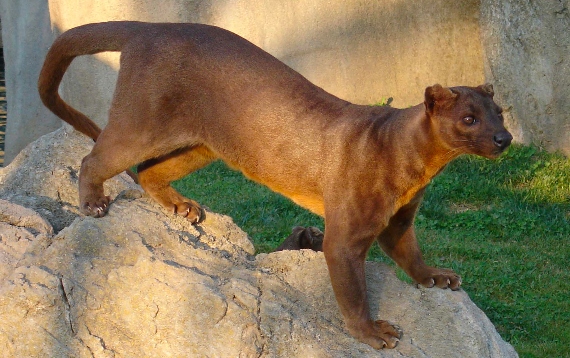
It is now accepted that the fossa constitutes a genus of its own (Cryptoprocta) within the Eupleridae family or the carnivores of Madagascar, which also includes the mongooses and civets endemic to the island. However, this difficulty in classification is not the reason for its scientific name, which describes the peculiar characteristic that the anus (“procta”) is hidden (“crypto”) behind a fold or anal sac. What those early discoverers were not wrong about is that the fossa—despite its modest size, at almost two metres long from muzzle to the tip of the tail and weighing 12 kilograms—is indeed Madagascar’s top predator, with lemurs being its favourite prey thanks to its ability to climb trees.
Sunda flying lemur (Gaelopterus variegatus)
The Sunda flying lemur or Malayan colugo, found mainly on the Malay Peninsula and the islands of Sumatra and Borneo, is a small, strictly arboreal mammal with a bizarre appearance. Its huge eyes, which allow it to be nocturnal, protrude from its small head. It has a retractable tail as long as the rest of its body, and a skin membrane called a patagium that extends from the neck to the tail on both sides of its body. Thanks to this membrane, the Sunda flying lemur can glide distances of up to 100 metres through the jungle. The patagium also serves as a sack or pouch with which the mother wraps her young for shelter and warmth.
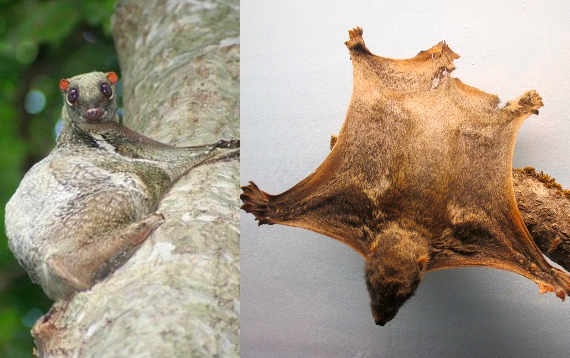
This combination of traits explains why it has been confused with some species of bat, marsupial, tree shrew or primate. In fact, until recently, scientists were still debating whether the Sunda flying lemur was actually an insectivore belonging to the order Scadentia (in which the aforementioned tree shrews are included) or whether it was a primate. The definitive answer was only reached in 2016 and thanks to genetics: the comparison of the animal’s genome with the DNA from 21 other mammalian species showed that Sunda flying lemurs constitute an order of their own (Dermoptera) within mammals, directly related to primates, and that the traits shared with shrews and other insectivores are the result of convergent evolution; in other words, they arose as an adaptation to their environment.
Atretochoana eiselti
The species Atretochoana eiselti was first vaguely described to science in 1968 by the American herpetologist Edward Taylor from a single specimen from Brazil in the collection of the Austrian Natural History Museum. For 30 years there was no further news of this creature, so much so that many doubted its actual existence. But in 1998, Brazilian herpetologists rediscovered another specimen in the collection of the University of Brasilia. Finally, in 2011, in Brazil’s Madeira River, six live specimens of this strange animal appeared: a kind of enormous worm almost a metre long and with a tiny head without nostrils and small, barely visible eyes.
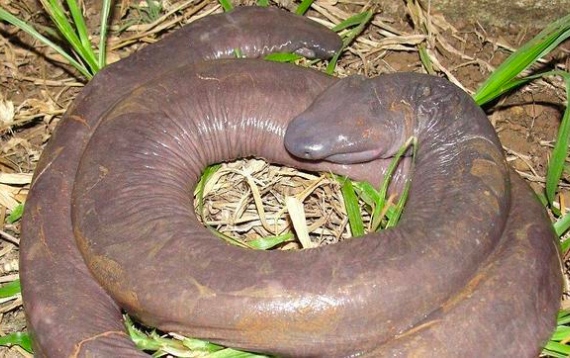
Despite what its appearance or nickname might suggest, the “penis snake” is neither a worm nor an ophidian, but a caecilian. The caecilians are a group of limbless amphibians and therefore closer to salamanders and batrachians, although ironically their scientific name Gymnophiona comes from the Greek for “naked snake” as they were once thought to be related to them. Atretochoana eiselti is, however, an exceptional cecilia as it is not only the largest—twice the size of the next in the classification—but also, unlike the vast majority of the members of this group, it lacks lungs and has to breath through its skin. It is therefore also the largest known tetrapod without lungs.
Gerbil (Dipodidae)
It’s neither a mouse nor a squirrel, nor a rabbit nor a tiny kangaroo, much less a cat, a lemur or a prairie dog. And, of course, it’s not some Frankenstein creature with a design based on imitations of those animals, although it exhibits typical characteristics of each of them. A gerbil is a unique member of the family of dipodids or jumping rodents.

Both for its size and for the appearance of its body and head, it could be confused with a mouse. However, its ears—larger and longer—resemble those of rabbits. Its long tail—which it uses as a stabiliser—its powerful legs, and its way of moving, making great jumps in rapid succession, are evocative of a miniature kangaroo. Its huge eyes, adapted to its nocturnal habits, resemble those of the lemur. And it has sensitive whiskers, like those of cats, and also some barely visible front legs, very similar to those of the prairie dog. All of these traits are necessary adaptations for its natural habitat: the deserts, where its feeds on plants and insects from which it also gets all the water it needs.
Platypus (Ornithorhynchus anatinus)
When the first Europeans landed on the southern continent, they found a fauna that in many cases they just could not describe, let alone classify: giant rats that moved around by jumping; small, hairy, greyish balls with a narrow elongated beak and robust legs, but lacking wings… And above all, a strange creature that seemed to defy all that was known and that for the aborigines was the fruit of love making between a water rat and a duck. With a physiognomy and fur similar to an otter, but with the bill of a duck, the tail of a beaver and webbed feet, it also lacked teeth and breasts—distinctive features of mammals, like hair—and it even laid eggs!

Perhaps it’s not so strange that when the first descriptions and specimens arrived back at the old continent, the naturalists considered them a joke or a forgery of the sailors. In reality, it was the platypus, one of the five species of monotremes (oviparous mammals) on the planet, all of which are native to Oceania.
The platypus is also unique because its beak, which is actually a flat, rubbery snout, is equipped with electroreceptors to detect its prey under the water of rivers and lakes, the habitat in which it spend almost all its time. In addition, males have a poisonous spur on their hind feet, and the mammary glands of females are so primitive that they lack teats; instead, they secrete milk through pores in the skin.
Aguará guazú or maned wolf (Chrysocyon brachyurus)
Despite what its name suggests, it’s not a wolf. In fact, it neither howls, nor forms herds, nor hunts in a group. And despite its appearance, with a long, small head with pointed snout, large ears and thick, reddish fur, it’s not a fox with legs that appear too long for his body (lending it an air of comic ungainliness) or a type of jackal or coyote. It’s known locally as the aguará guazú, the largest canid in South America and possibly the strangest one on the entire planet. Its disproportionately long legs are an evolutionary adaptation for the environment in which it lives—the high grasslands—since they enable it to scrutinise the ground from a height in search of possible prey—basically rodents, lizards or eggs.
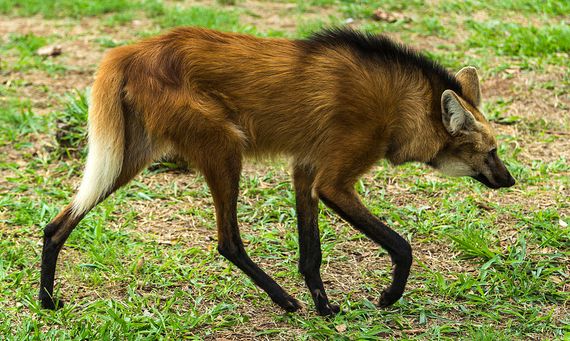
However, although it is omnivorous, the diet of the maned wolf is primarily vegetable matter, based on roots and fruits. Therefore, its dentition is quite different from that of other canids, with less-developed incisors and large molars, more typical of herbivores.
Another curious feature is that, although it can run fast, it almost never resorts to doing so, usually limiting itself to walking. What’s more, its manner of walking is unlike the rest of the canids but more like a hyena, with a gait characterised by first moving the two legs on one side and then the other, which reinforces its ungainly air.
Star-nosed mole (Condylura cristata)
This chimerical creature has the body of a mole and a starfish instead of a snout. Except that the alleged starfish is, in fact, a sensitive organ consisting of 22 appendages or fingers arranged in a crown around the fovea or central area. It’s actually the most sophisticated tactile organ found in the animal kingdom thanks to its more than 100,000 nerve fibres, five times more than the number concentrated on the surface of a human fingertip, which allow this mole to decide whether a potential food item is edible or not in less than 8 milliseconds. The star-like organ is also ideal for making a perfect and detailed three-dimensional map of its environment.
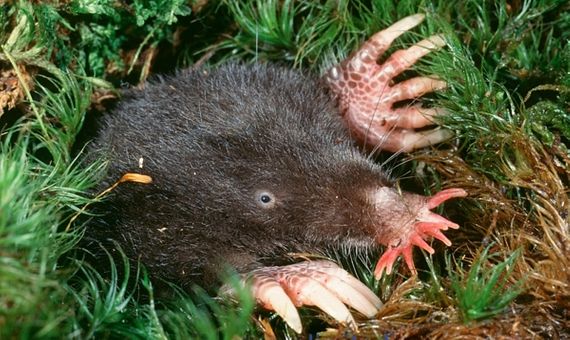
Its powerful front legs topped by curved claws, like a shovel, make this tiny, hamster-sized mammal an expert tunneler. In addition, and given that it inhabits marshes and swamplands, it doesn’t hesitate to dive underwater in search of food. It’s also the only known mammal capable of smelling underwater, something that it manages to do by exhaling air bubbles onto objects or scent trails that it then traps with its prodigious starry organ and re-inhales through the nose to detect chemical signals.
Pangolin (Manis sp)
For a long time, pangolins were grouped together with armadillos and anteaters, due to their apparent resemblance to these species. However, they are such unique animals that they were finally classified in a separate order: Pholidota. It is the only mammal with scales, forming a sort of armour that covers the top of the head, back and tail, serving as protection against its predators. When it feels threatened, the pangolin curls itself up into an armoured ball, tucking its face under its tail.
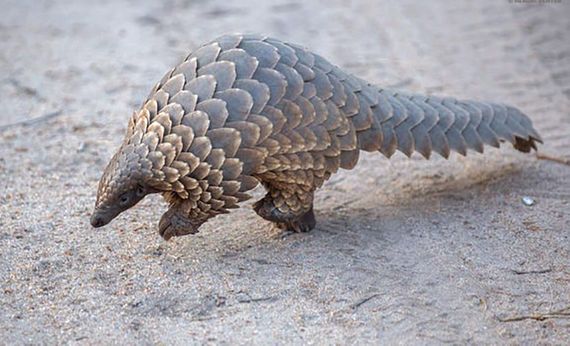
Another striking aspect of its appearance is its tubular snout and small toothless mouth, which contains a narrow, muscular, sticky tongue; it’s so long that it’s attached to a pelvis bone and remains rolled up in a sac inside the throat until the pangolin sticks it into anthills and termite mounds to feed itself. And in case those peculiarities weren’t enough, some species of pangolin can stand on two legs and, with the support and anchoring provided by their voluminous prehensile tail, advance with a comical wobble.
Comments on this publication